【公开课听课记录】2019年英语教研组公开课听课记录表
- 格式:doc
- 大小:43.50 KB
- 文档页数:4

英语听课记录1(总5页)--本页仅作为文档封面,使用时请直接删除即可----内页可以根据需求调整合适字体及大小--听课记录一:Lesson type: GrammarTeaching objectives: By the end of the lesson, most of the students will be able to…1. Language skills:read the passage and fill in the blanks with modal verbs correctly.2. Language knowledge:understand and use the modal verbs: can, may, must.3. Learning strategies:grasp a language point through summing up the key points in a table.Teaching focus:the understanding of the grammar: modal verbs (can, may, must).Teaching procedure:Step 1 Warming up1. Questions and lead-in: Can Daisy buy a packet of electricity at last (Yes, she can.)2. Brainstorming: Think about as many modal verbs as you can.Step 2 Grammar learning and practicingA. can1. Fill in the table about “can”.2. Make sentences about your special abilities with “I can…”.3. Read the dialogue between Hi and Lo and complete the sentences with “can/ can’t”.B. may1. Read the sentences of “may/ may not”, and fill in the table about “may”.2. Play a game about “may/ may not”.3. Complete the sentences with “may/ may not”.4. Have a role-play using “may/ may not”.C. must1. Read the sentences of “must/ must not”, and fill in the table about “must”.2. (1) Set a scene: Daily saw a doctor and he told her what to do and what not to do. (2) Assign a task: Help Daisy write down the doctor’s instruction with “must/ mustn’t”.3. Play a game about “mustn’t”: What do these sighs mean?4. Make rules with “must n’t” for our class and draw signs.C. Bingo GameStep 3 SummarySum up the grammar.Step 4 HomeworkAssign homework.Advantage and disadvantage:1. Advantages:(1) Great smile on the face.(2) Amiable to the students.2. Disadvantages:(1) Low voice.(2) Fast speed when reading the instructions of the exercise.(3) Unclear instructions.(4) Not funny.(5) Disobedient to the students’ cognitive laws.(6) Poor knowledge of English . the false explanation about“heater”).听课记录二:Lesson type: WritingTeaching objectives: By the end of the lesson, most of the students will be able to…1. Language skills:write a passage on “Cats/ Dogs/ Birds/ …makes the best pet”.2. Language knowledge:(1) understand and grasp the structure of an argumentative.(2) grasp some good expressions in demonstrating one’s opinion such as First, Second, What’s more,etc.3. Learning strategies:Analyze the structure of an argument by finding out its Introduction, Body and Conclusion and the supporting details.Teaching focus:The structure of an argumentative.Teaching procedure:Step 1 Warming up1.Greeting.2.Free talk: What animal do you suggest Tom to buyStep 2 Pre-writing1. Find out the structure of the text learned (Introduction, Body, Conclusion).2. Find out the reason and the supporting details for each paragraph of the body.3. Read another passage and finish the table on P92.4. Summarize the structures and expressions.Step 3 While-writing1. Group work: Discuss and finish the table, then share.2. Individual work: Write a passage on “Cats/ Dogs/ Birds/ …makes the best pet”.Step 4 Post-writing1. Class conferencing2. Pair work: Exchange and correct.Step 5 SummarySum up the structure and expressions of writing.Step 6 HomeworkAssign the homework.Advantage and disadvantage:1. Advantages:(1) Clear structure.(2) Enough interaction with the students.(3) Enough input and output for the students.(4) Amiable to the students.(5) Good oral English.(6) Good basis of English knowledge.2. Disadvantages:(1) Should more smile on the face.(2) Should teacher the students with love.听课记录三:Lesson type: RevisionTeaching objectives: By the end of the lesson, most of the students will be able to…1. Language skills:describe the features of animals such as horse, cat, fish, etc.2. Language knowledge:consolidate the words learned in this unit.3. Affectdevelop the awareness of protecting animals.Teaching focus:the words and features of the animals.Teaching procedure:Step 1 Warming up1. Greeting.2. TPL:(1) Oral instruction: One two three – A B C(2) Reaction: One/ Two/ Three/… - Finger shape(3) Game: Listen and do.3. Sing a song:(1) Set a scene (picture): They are going to Ben’s uncle’s farm.(2) Sing a song: BingoStep 2 Revision1. Let’s spy: What animals can you see (Ss use a piece of paper as a telescope)(1) It has four legs and a long tail: horse.(2) It has a long tail: monkey(3) It has a long nose and big ears: elephant.2. Let’s listen and number.3. Let’s look, read and choose:(1) Set a scene: Suddenly, there is a thunder. The animals hide.(2) Describe: What can you see?*mind map (body): tail(s), leg(s), ear(s), eye(s), mouth(s), nose(s), feet, hair, …(3) Do the exercise: Look, read and choose.(4) Group work: share the answers.4. Let’s sum up:- How many …(s) are there?- There are …/ There is…5. Let’s guess (riddles)(1) cat.(2) dog(3) Show a video: dogs are human’s friends.9. Let’s describe(1) Group work:a. fish: It’s … It’s … It has a short … It has two small eyes.b. chicken: It’s … It’s … It has … It has …c.duck: It’s … It’s … It has … It has …(2) Do the exercise: Read and choose.10. Let’s sum up:- 描述一个时:It has…- 描述两个时:They have…11. Let’s look, say and guess(1) Individual work(2) Pair work: Share and guess.12. Expansion:(1) Pictures of other animals.(2) Video about a pet.(3) Summary Aimals are our friends.Step 3 Self-assessment1. Group work: Discuss and finish the table, then share.2. Individual work: Write a passage on “Cats/ Dogs/ Birds/ …makes the best pet”.Step 4 HomeworkDraw and tell.Advantage and disadvantage:1. Advantages:(1) Funny.(2) Colorful pictures.(3) Good exercise.(4) Good preparation for each part (from language input to output)(5) Strong love for the students.(6) Young heart and positive attitude,2. Disadvantages:Poor oral English.。
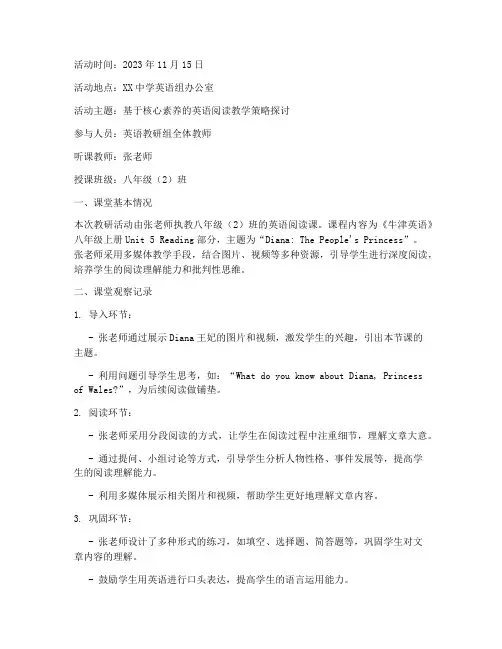
活动时间:2023年11月15日活动地点:XX中学英语组办公室活动主题:基于核心素养的英语阅读教学策略探讨参与人员:英语教研组全体教师听课教师:张老师授课班级:八年级(2)班一、课堂基本情况本次教研活动由张老师执教八年级(2)班的英语阅读课。
课程内容为《牛津英语》八年级上册Unit 5 Reading部分,主题为“Diana: The People's Princess”。
张老师采用多媒体教学手段,结合图片、视频等多种资源,引导学生进行深度阅读,培养学生的阅读理解能力和批判性思维。
二、课堂观察记录1. 导入环节:- 张老师通过展示Diana王妃的图片和视频,激发学生的兴趣,引出本节课的主题。
- 利用问题引导学生思考,如:“What do you know about Diana, Princess of Wales?”,为后续阅读做铺垫。
2. 阅读环节:- 张老师采用分段阅读的方式,让学生在阅读过程中注重细节,理解文章大意。
- 通过提问、小组讨论等方式,引导学生分析人物性格、事件发展等,提高学生的阅读理解能力。
- 利用多媒体展示相关图片和视频,帮助学生更好地理解文章内容。
3. 巩固环节:- 张老师设计了多种形式的练习,如填空、选择题、简答题等,巩固学生对文章内容的理解。
- 鼓励学生用英语进行口头表达,提高学生的语言运用能力。
4. 总结环节:- 张老师引导学生回顾本节课所学内容,总结Diana王妃的生平事迹,培养学生的爱国主义情怀。
- 提出思考性问题,引导学生对文章内容进行批判性思考,如:“What can we learn from Diana’s life?”三、评课意见1. 优点:- 张老师的教学设计合理,教学方法多样,能够激发学生的学习兴趣。
- 注重培养学生的阅读理解能力和批判性思维,提高学生的英语素养。
- 课堂气氛活跃,学生参与度高,教学效果良好。
2. 不足:- 部分学生对文章内容的理解不够深入,需要教师在课堂上给予更多引导。
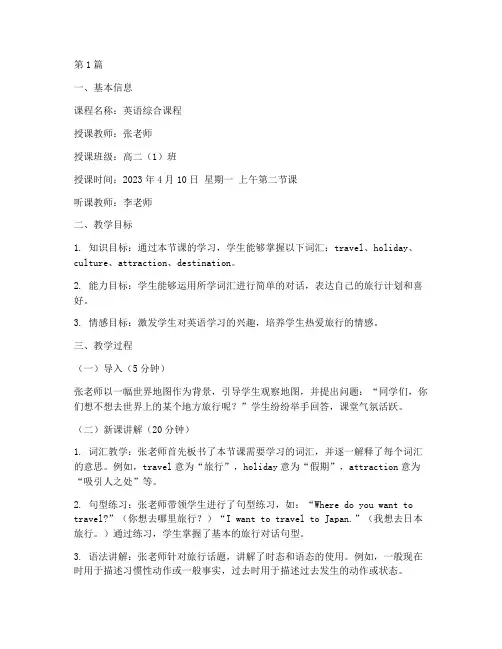
第1篇一、基本信息课程名称:英语综合课程授课教师:张老师授课班级:高二(1)班授课时间:2023年4月10日星期一上午第二节课听课教师:李老师二、教学目标1. 知识目标:通过本节课的学习,学生能够掌握以下词汇:travel、holiday、culture、attraction、destination。
2. 能力目标:学生能够运用所学词汇进行简单的对话,表达自己的旅行计划和喜好。
3. 情感目标:激发学生对英语学习的兴趣,培养学生热爱旅行的情感。
三、教学过程(一)导入(5分钟)张老师以一幅世界地图作为背景,引导学生观察地图,并提出问题:“同学们,你们想不想去世界上的某个地方旅行呢?”学生纷纷举手回答,课堂气氛活跃。
(二)新课讲解(20分钟)1. 词汇教学:张老师首先板书了本节课需要学习的词汇,并逐一解释了每个词汇的意思。
例如,travel意为“旅行”,holiday意为“假期”,attraction意为“吸引人之处”等。
2. 句型练习:张老师带领学生进行了句型练习,如:“Where do you want to travel?”(你想去哪里旅行?)“I want to travel to Japan.”(我想去日本旅行。
)通过练习,学生掌握了基本的旅行对话句型。
3. 语法讲解:张老师针对旅行话题,讲解了时态和语态的使用。
例如,一般现在时用于描述习惯性动作或一般事实,过去时用于描述过去发生的动作或状态。
(三)课堂活动(15分钟)1. 小组讨论:张老师将学生分成四人一组,要求他们讨论自己假期的旅行计划,并用英语表达出来。
2. 角色扮演:学生分成两组,一组扮演旅行者,另一组扮演导游。
旅行者向导游询问旅行路线、景点等信息,导游用英语回答。
(四)总结与作业布置(5分钟)张老师对本节课的内容进行了总结,并布置了以下作业:1. 请用英语写一篇关于自己假期的旅行计划的短文。
2. 收集五个关于旅行的英语短句,并翻译成中文。
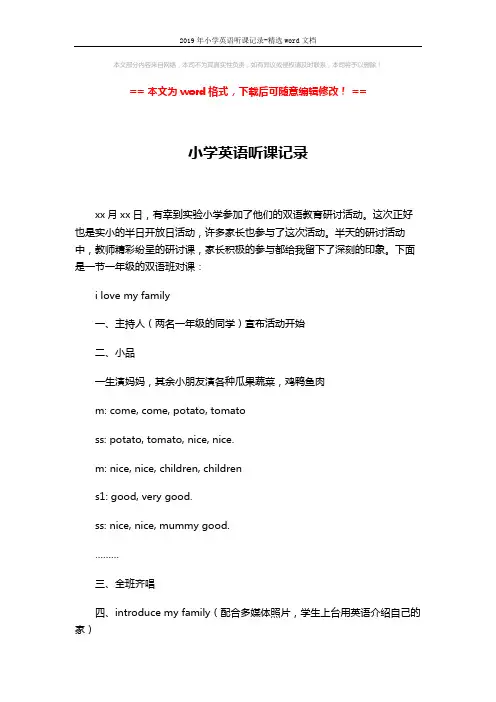
2019年小学英语听课记录-精选word文档
本文部分内容来自网络,本司不为其真实性负责,如有异议或侵权请及时联系,本司将予以删除!
== 本文为word格式,下载后可随意编辑修改! ==
小学英语听课记录
xx月xx日,有幸到实验小学参加了他们的双语教育研讨活
动。
这次正好也是实小的半日开放日活动,许多家长也参与了这次活动。
半天的研讨活动中,教师精彩纷呈的研讨课,家长积极的参与都给我留下了深刻的印象。
下面是一节一年级的双语班对课:
i love my family
一、主持人(两名一年级的同学)宣布活动开始
二、小品
一生演妈妈,其余小朋友演各种瓜果蔬菜,鸡鸭鱼肉
m: come, come, potato, tomato
ss: potato, tomato, nice, nice.
m: nice, nice, children, children
s1: good, very good.
ss: nice, nice, mummy good.
………
三、全班齐唱
四、introduce my family(配合多媒体照片,学生上台用英语介绍自己的家)。
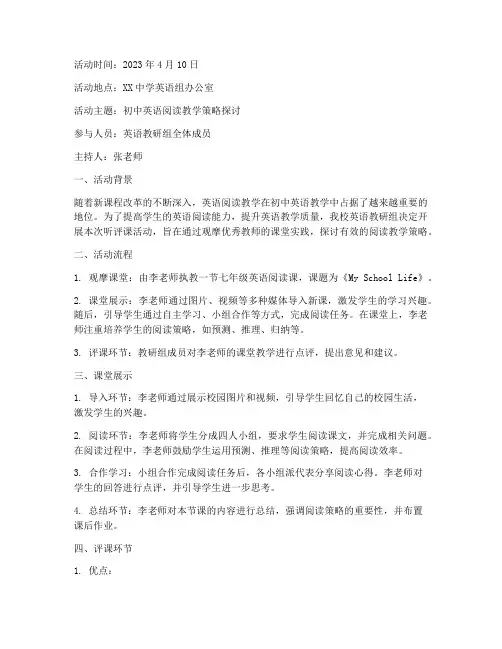
活动时间:2023年4月10日活动地点:XX中学英语组办公室活动主题:初中英语阅读教学策略探讨参与人员:英语教研组全体成员主持人:张老师一、活动背景随着新课程改革的不断深入,英语阅读教学在初中英语教学中占据了越来越重要的地位。
为了提高学生的英语阅读能力,提升英语教学质量,我校英语教研组决定开展本次听评课活动,旨在通过观摩优秀教师的课堂实践,探讨有效的阅读教学策略。
二、活动流程1. 观摩课堂:由李老师执教一节七年级英语阅读课,课题为《My School Life》。
2. 课堂展示:李老师通过图片、视频等多种媒体导入新课,激发学生的学习兴趣。
随后,引导学生通过自主学习、小组合作等方式,完成阅读任务。
在课堂上,李老师注重培养学生的阅读策略,如预测、推理、归纳等。
3. 评课环节:教研组成员对李老师的课堂教学进行点评,提出意见和建议。
三、课堂展示1. 导入环节:李老师通过展示校园图片和视频,引导学生回忆自己的校园生活,激发学生的兴趣。
2. 阅读环节:李老师将学生分成四人小组,要求学生阅读课文,并完成相关问题。
在阅读过程中,李老师鼓励学生运用预测、推理等阅读策略,提高阅读效率。
3. 合作学习:小组合作完成阅读任务后,各小组派代表分享阅读心得。
李老师对学生的回答进行点评,并引导学生进一步思考。
4. 总结环节:李老师对本节课的内容进行总结,强调阅读策略的重要性,并布置课后作业。
四、评课环节1. 优点:- 李老师课堂氛围活跃,激发了学生的学习兴趣。
- 注重培养学生的阅读策略,提高学生的阅读能力。
- 教学环节设计合理,教学目标明确。
- 课堂评价及时、准确,有助于学生巩固所学知识。
2. 不足:- 部分学生参与度不高,课堂互动性有待提高。
- 阅读任务难度适中,但可以适当增加挑战性,提高学生的思维能力。
- 课堂时间分配不够合理,部分环节可以适当缩短。
五、讨论与总结1. 讨论:- 如何提高学生的阅读兴趣?- 如何在阅读教学中培养学生的阅读策略?- 如何在课堂中提高学生的参与度?2. 总结:- 本次听评课活动取得了圆满成功,为英语教研组提供了宝贵的经验。

英语教研组活动记录表英语教研组活动记录表英语教研组活动记录表英语教研组活动记录表英语教研组活动记录表英语教研组活动记录时间:地点:办公室主持人:何冠英参加人员:英语组全体老师活动主题:如何培养学困生的英语学习兴趣,提高英语教学质量个人发言:针对各位老师所提出问题,经过大家热烈讨论,英语组就以后如何进行有效教学,如何提高学习英语兴趣、提高成绩达成以下共识。
一、对学困生学生的英语教学,努力活跃课堂气氛,力争让学生全体参与。
着力培养学生英语学习兴趣,提升学生的英语学习信心。
角色扮演、课本剧,老师一定要尝试,坚持实施,让学生有一种学习体验。
二、不教、不讲非考纲词汇,更不让学习识记,减轻学生负担。
对学有余力的同学,老师可单独补充学习。
三、教学内容分化,每节课少教、少讲,多让学生“动起来”。
词汇教学一定要情境化,不要集中教词汇。
语法少讲,甚至不讲。
让学生多读对话,多读课文,主动去“发现”。
四、教师要注意学生良好的学习习惯,自主学习的能力,英语学习的能力。
开始可能会很难,但一定要坚持。
这才是最终的解决方法。
五、充分利用家校通,在学校和家长之家架起一座桥梁,促进多方面参与,俗话说的好单木不成林,我们只有开发好这个资源,才能更利用教学质量的提高,学生能力的提升。
本次教研活动讨论的主题是“规范英语教学常规管理,全面提升教学质量”,大家以为最重要做到以下几点:1. 认真备课。
教案是教师实施教学的蓝本。
要备好课必须钻研课程标准,钻研教材,熟悉教材的内在联系和编写意图,目的要求和重点、难点。
要备好课必须研究面对的学生,熟悉他们的已有认知和能力,让他们处在智力的最接近发展区,要备好课必须发挥组内每位教师的优势,要虚心好学,取人之长、补己之短。
要有悟性,不断有新的发现和灵感,充实和完善自己的教案。
要备好课必须适当借助现代教学手段,发挥其不可替代的作用,充分利用各种信息,丰富教案。
2. 认真上课。
课堂教学是所有教学环节的中心环节,小学英语课堂教学中要关注学生的生活和情感。
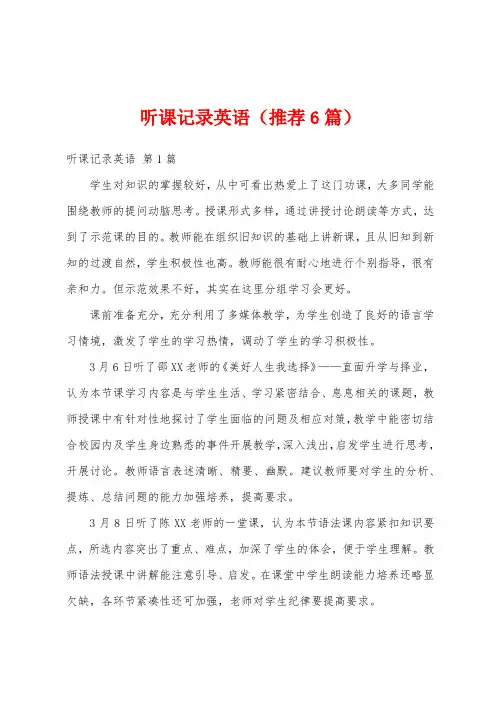
听课记录英语(推荐6篇)听课记录英语第1篇学生对知识的掌握较好,从中可看出热爱上了这门功课,大多同学能围绕教师的提问动脑思考。
授课形式多样,通过讲授讨论朗读等方式,达到了示范课的目的。
教师能在组织旧知识的基础上讲新课,且从旧知到新知的过渡自然,学生积极性也高。
教师能很有耐心地进行个别指导,很有亲和力。
但示范效果不好,其实在这里分组学习会更好。
课前准备充分,充分利用了多媒体教学,为学生创造了良好的语言学习情境,激发了学生的学习热情,调动了学生的学习积极性。
3月6日听了邵XX老师的《美好人生我选择》——直面升学与择业,认为本节课学习内容是与学生生活、学习紧密结合、息息相关的课题,教师授课中有针对性地探讨了学生面临的问题及相应对策,教学中能密切结合校园内及学生身边熟悉的事件开展教学,深入浅出,启发学生进行思考,开展讨论。
教师语言表述清晰、精要、幽默。
建议教师要对学生的分析、提炼、总结问题的能力加强培养,提高要求。
3月8日听了陈XX老师的一堂课,认为本节语法课内容紧扣知识要点,所选内容突出了重点、难点,加深了学生的体会,便于学生理解。
教师语法授课中讲解能注意引导、启发。
在课堂中学生朗读能力培养还略显欠缺,各环节紧凑性还可加强,老师对学生纪律要提高要求。
3月8日听了秦XX老师的《透镜光的折射》一课,认为教师语言表述能力好,课堂讲解层次清晰,注重启发、拓展,教师的基本功扎实,讲解中注重知识的记忆、整理,结合习题在授课中及时巩固,并做到精批精讲,板书相当清晰、规范。
但做为复习课,对学生能力要求可再提高一些,课堂上可适当给予学生互动的空间。
教学重难点突出,板书清晰有条理。
教学步骤设计合理,由浅入深,循序渐进。
教师基本功扎实,知识讲解准确,教学设计合理,始终以学生为主体,自主学习,小组交流讨论,上台交流展示等形式,师生配合默契,取得了较好的学习效果。
听课记录英语第2篇根据四年级学生好奇心浓厚的特点,并根据小学英语中要注意培养学生发散性思维能力,认真观察,注意倾听并能用英语进行简单交流的目的,联系本课特点,从培养的语言能力入手,通过各种方式,运用学生身边的事物,合理地运用语言材料,培养学生的思维与使用英语的能力。
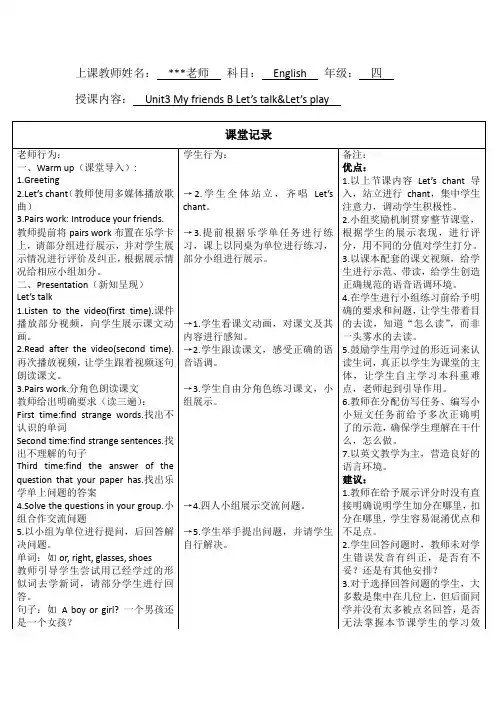

英语听课记录文档编制序号:[KK8UY-LL9IO69-TTO6M3-MTOL89-FTT688]听课记录一:Lesson type: WritingTeaching objectives:By the end of this lesson, students will be able to…1. Language skills:1) Speaking: talk about what pollutions the earth has, why there are pollutions on earth and how to protect the earth;2) Writing: write an article on How to protect the earth using expressions they have learnt in this lesson.2. Language knowledge:1) Vocabulary: identify some new words and expressions: pollute, pollution, fewer and fewer, waste, stop doing sth., less, save, link words(and, then, when…)2) Topic: discuss daily and environmental pollution by using expressions from the text.3. Affect:Be aware of the importance of environmental protection and express their opinions on environmental pollution.4. Learning strategies:Improve writing evaluating fellow student’s work.Teaching focus:Help students to use the phrases and expression to write the article.Teaching procedure:Step 1: Lead in1. Greet the students.2. Ask the students and help them to recall what they havelearnt in the last lesson.3. Show pictures of the beautiful earth and the polluted earth, ask the students why the earth is dirty now, and lead in one of the problems “pollution”.Step 2: Presentation1. Ask the students what problems do the earth has (problems) and what bad things do students do to the earth (reasons).2. Show new words and phrases relevant to these questions.Step 3: Discussion1. Ask the students to discuss in groups what they can do to protect the earth (solutions).2. Ask the students to share their thoughts.Step 4: SummarySum up the solutions by showing pictures and phrases,preparing students for writing.Step 5: Writing1. Show the writing task and give a writing pattern to the students.2. Ask students to take out notebooks to write.Step 6: Evaluation1. Introduce the Evaluation Form in which there are rules of giving points.2. Ask the students to exchange their articles with their partners and check each other’s.3. Pick up some students to show their articles through OHP, ask them to read out the articles.4. Evaluate the articles with the whole class according to the Evaluation Form. (Class Conferencing)Step 7: SummarySum up the key words and phrases in this writing class.Step 8: Assignment1. Finish the exercise on the paper.2. Recite the words.Advantage and disadvantage:1. Advantages:1) Use English throughout the lesson;2) Give positive responses to students;3) Carry out the procedures both clearly and coherently;4) Have a good control of time;5) Give out the instructions in a brief and clear way;6) The writing part is closely related to life;7) The pictures of the slide are approachable in daily life;8) The words, phrases and sentences mentioned are useful for writing.2. Disadvantages:1) Lack of smile;2) Ignore students’ creativity in writing;3) The writing form should not be given to students at the very beginning, which limits students’ expression.听课记录二:Lesson type: GrammarTeaching objectives:By the end of this lesson, students will be able to…1. Language Knowledge:Grammar:1) know the meaning of the comparative of adjectives;2) understand the usage of the comparative of adjectives.2. Language skills:1) use the comparative of adjectives to compare two or more persons and objects;2) use language through discovering language and learning language;3. Affect:1) develop team spirit;.2) develop the awareness of helping each other.Teaching focus:Help students to discover language, learn language and use language.Teaching procedure:Step 1: Warming up and lead-in1. Listen to a song, fill the blanks and guess the title ofthe song.2. Pair work: discuss and check the answers quickly.3. Lead in the Grammar, The comparative of adjectives.Step 2: Discovering language1. Group work: write down two sentences with the comparativeof adjectives from the text quickly and speak out the features of the sentences.2. Pick up several groups to show their sentences; whole class read them loudly.3. Circle the features (bigger, smaller, better…), ask students to tell what it is (Ss: The comparative of adjectives). Step 3: Learning languageTask 1:1. Show a picture of Grace, ask students to describe her (Ss: …/T write down the adjectives on blackboard).2. Ask the students how to change these adjectives into comparative forms (Ss: …/T write down the comparative forms on blackboard).Task 2: Work out the rules1. Look at the adjectives and their comparative forms (according to 5 rules), try do find out the rules.2. Show the rules of the comparative forms in a table (systematized), ask students to fill the table and write down examples for each rule (time limit, T: giving stars as prizes); ask different students to show their answers.Task 3:1. Finish the exercise from P39 to P40 (time limit, T: ask the slowest students to show their answers); pair work: discuss and check the answers;2. Whole class read it through.Step 4: Using language1. Show pictures of iphone5 and iphone6 with their detailed information (Height/ Width/ Depth/ Weight/ Price) and a photo of a family.2. Pair work: ask students to introduce these two phones (giving tips for adjectives that can be used; can imitate the dialogue on P39).3. Role play: act out the dialogue.Step 5: SummarySum up the grammar - the comparative of adjectives (T: What we have learnt today? Ss: Grammar. T: What grammar? Ss: The comparative of adjectives).2. Ask students to take out notebooks to write.Step 6: AssignmentHomework.Advantage and disadvantage:1. Advantages:1) Use Task-bases Approach and Inductive Approach to teach the grammar;2) Focus on the basic principles of the grammar, avoid knowledge extension while teaching grammar;3) Apply the grammar to practical use;4) Give positive responses to students who behave well (by giving out stars);5) Have funny ways to refresh students’ spirit and help them focus their minds (by clapping hands, this has already been a habit throughout their English learning);6) The teaching plan and procedures are clear, logical and natural;7) Carry out the teaching procedures smoothly;8) The instructions are brief, clear and powerful.* 9) The procedures move so quickly that leave no time for students to wander.2. Disadvantages:The procedures move much too quickly which is demanding for students especially the low-level students.听课记录三:Lesson type: GrammarTeaching objectives:By the end of this lesson, students will be able to…1. Language Knowledge:Grammar:1) know the meaning of the comparative of adjectives;2) understand the usage of the comparative of adjectives.2. Language skills:1) use the comparative of adjectives to compare two or more persons and objects;2) use language through discovering language and learning language;3. Affect:1) develop team spirit;.2) develop the awareness of helping each other.Teaching focus:Help students to discover language, learn language and use language.Teaching procedure:Step 1: Warming up and lead-in1. Show pictures of some of students in this class, ask the students “Who is taller/who is happier/who is thinner/who is more hard-working, xx or xx? respectively.2. Show the sentences “xx is taller/shorter/happier/morehard-working than xx” all together, circle the key parts ofthe sentences, ask the students what it is (lead in the grammar-the comparative of adjectives).Step 2: Look and answer (work out the simple rules)1. Show pictures of two pairs of objects with two adjectiveson it, ask students to fill the blank like “Which is ____, the red flower or yellow one? (big, beautiful)”, then show the complete sentences as answers.2. Read all the sentences and work out the rules. (Rules: To form the comparative of adjectives, we often add er to short adjectives and use more with long adjectives. We often use than after the comparative of adjectives.)3. Circle the features (bigger, smaller, better…), ask students to tell what it is (Ss: The comparative of adjectives). Step 3:Task 1: Finish the exercise and work out the rules (handout)1. Finish the exercise (e.g. 1. fat: My friend is ___ than me.)2. Look at the answers, tell the rules (specific rules).Task 2: Group work1. Look around the meeting room and find out as many adjectives as you can to describe it. (Ss: …/ T: write down the adjectives on blackboard)2. Let’s compare our classroom with the meeting room (showing a picture of the student s’ classroom/ T: Whose classroom is it?), give an example to the students: The meeting room is larger than our classroom.3. Ask group representatives to show their answers.4. Show all the sentences and draw forth the sentence structure of the comparative (A+be+形容词比较级+than+B.), ask students to take notes.Task 3: Discuss and write-Which is your favourite, Mi4 or iphone6?1. Show pictures of Mi4 and iphone5 with their detailed information (Price/ Appearance/ Function/ Popularity).2. Discuss and find some adjectives to describe the two kinds of mobile phones.3. Ask students to show their answers.4. Writing: Compare the two mobile phones and tell us your choice.I like ____ better because it is ____ than ____. Secondly,it is ____ than ____. Thirdly, ____________. Finally,____________.5. Pick up some students to read out their articles.Step 4: SummarySum up the grammar - the comparative of adjectives by showing some sentences and re-show the simple rules. (Rules: To formthe comparative of adjectives, we often add er to short adjectives and use more with long adjectives. We often use than after the comparative of adjectives.).Step 5: Assignment1. Recite the words.2. Recite the text.Advantage and disadvantage:1. Advantages:1) Use Task-based and Inductive Approach to teach the grammar;2) Focus on the basic principles of the grammar;3) Apply the grammar to practical use;6) The teaching plan and procedures are clear, logical and natural;7) Carry out the teaching procedures smoothly;8) The instructions are brief, clear and powerful.2. Disadvantage: lack of smile.。
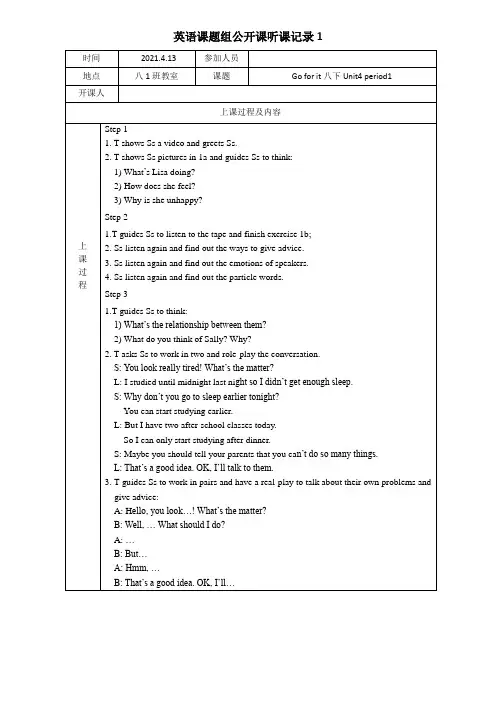
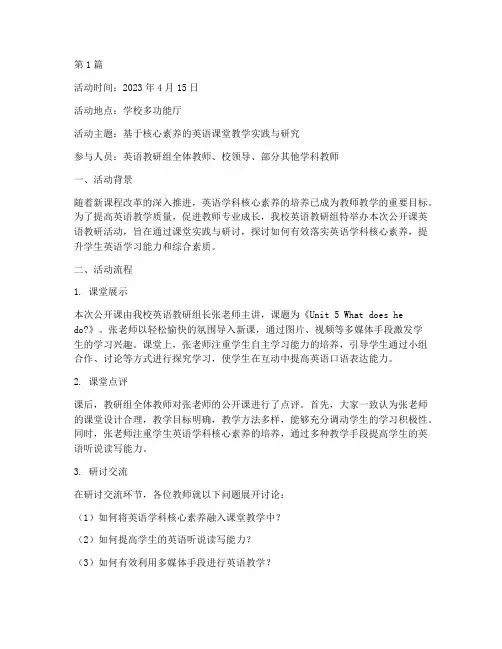
第1篇活动时间:2023年4月15日活动地点:学校多功能厅活动主题:基于核心素养的英语课堂教学实践与研究参与人员:英语教研组全体教师、校领导、部分其他学科教师一、活动背景随着新课程改革的深入推进,英语学科核心素养的培养已成为教师教学的重要目标。
为了提高英语教学质量,促进教师专业成长,我校英语教研组特举办本次公开课英语教研活动,旨在通过课堂实践与研讨,探讨如何有效落实英语学科核心素养,提升学生英语学习能力和综合素质。
二、活动流程1. 课堂展示本次公开课由我校英语教研组长张老师主讲,课题为《Unit 5 What does he do?》。
张老师以轻松愉快的氛围导入新课,通过图片、视频等多媒体手段激发学生的学习兴趣。
课堂上,张老师注重学生自主学习能力的培养,引导学生通过小组合作、讨论等方式进行探究学习,使学生在互动中提高英语口语表达能力。
2. 课堂点评课后,教研组全体教师对张老师的公开课进行了点评。
首先,大家一致认为张老师的课堂设计合理,教学目标明确,教学方法多样,能够充分调动学生的学习积极性。
同时,张老师注重学生英语学科核心素养的培养,通过多种教学手段提高学生的英语听说读写能力。
3. 研讨交流在研讨交流环节,各位教师就以下问题展开讨论:(1)如何将英语学科核心素养融入课堂教学中?(2)如何提高学生的英语听说读写能力?(3)如何有效利用多媒体手段进行英语教学?(4)如何培养学生的英语学习兴趣?针对以上问题,各位教师结合自身教学实践,分享了各自的经验和心得。
以下是部分教师的发言摘要:(1)李老师:在课堂教学中,我们要关注学生的个体差异,根据学生的实际情况,制定合适的教学目标。
同时,注重培养学生的自主学习能力,鼓励学生积极参与课堂活动。
(2)王老师:多媒体手段在英语教学中具有重要作用。
我们可以利用图片、视频、音频等多种形式,激发学生的学习兴趣,提高课堂效率。
(3)刘老师:培养学生的英语学习兴趣是提高英语教学质量的关键。
Date: [Insert Date]Location: [Insert Venue]Time: [Insert Time]Participants:- [Insert Names] - Group Leaders- [Insert Names] - Observers- [Insert Names] - English Teachers- [Insert Names] - Teaching AssistantsObjective:The primary objective of this listening and learning activity was to enhance the teaching and learning of English within our group by observing and analyzing the effectiveness of various teaching methods, strategies, and techniques used by our colleagues. This activity aimed to promote collaboration, reflection, and continuous improvement in English language teaching practices.Agenda:1. Preparation and Introduction (15 minutes)- The group leaders provided a brief overview of the activity's purpose and expectations.- Participants were reminded of the criteria for evaluating the lessons and the importance of constructive feedback.2. Observation of the Lesson (45 minutes)- The first lesson observed was conducted by [Insert Teacher's Name], focusing on the topic of [Insert Topic].- The observers took detailed notes on the following aspects:- Introduction and engagement- Teaching methods and strategies- Interaction and participation- Assessment and feedback- Overall effectiveness3. Reflection and Discussion (30 minutes)- The group engaged in a reflective discussion based on the observations.- Key points from the discussion included:- Strengths:- The teacher effectively engaged the students from the beginning with a thought-provoking question.- The use of varied teaching methods, such as group work and individual tasks, ensured active participation.- The teacher provided timely and constructive feedback, which helped students to understand their mistakes and improve.- Areas for Improvement:- The teacher could have used more visual aids to enhance the understanding of complex vocabulary.- The pacing of the lesson could be adjusted to allow more time for student practice and application of the language.- More opportunities for oral interaction could be incorporated to improve speaking skills.4. Feedback and Recommendations (20 minutes)- Each observer shared their feedback, focusing on both positive aspects and areas for improvement.- Recommendations were made to the teacher based on the group's observations and discussions:- Incorporate more visual aids and real-life examples to aid comprehension.- Provide additional speaking activities to reinforce language skills.- Consider varying the pacing of the lesson to ensure all students have the opportunity to participate and learn.5. Closing Remarks (10 minutes)- The group leaders summarized the key takeaways from the activity.- They emphasized the importance of ongoing professional development and the value of collaborative learning within the English教研组.Observation Notes:Teacher's Name: [Insert Teacher's Name]Lesson Topic: [Insert Topic]Grade Level: [Insert Grade Level]Duration: 45 minutesIntroduction and Engagement:- The teacher began the lesson with a warm-up activity, which helped to focus the students' attention and set the tone for the lesson.- The teacher used a thought-provoking question to stimulate interest and encourage thinking.Teaching Methods and Strategies:- The teacher employed a variety of teaching methods, including:- Direct instruction- Guided practice- Independent practice- Group work- The use of interactive whiteboard and handouts was effective in illustrating key concepts.Interaction and Participation:- The students were actively engaged throughout the lesson, with most participating in discussions and activities.- However, some students seemed less engaged and could have been encouraged to participate more.Assessment and Feedback:- The teacher provided timely and constructive feedback, which helped students to understand their mistakes and improve.- The assessment methods used were appropriate for the lesson objectives.Overall Effectiveness:- The lesson was well-structured and delivered with enthusiasm.- The teacher effectively managed the classroom and maintained apositive learning environment.Reflection on the Activity:The listening and learning activity was a valuable opportunity for our English教研组 to come together and reflect on our teaching practices. The observation and discussion sessions allowed us to identify both the strengths and areas for improvement in our colleagues' teaching methods. We are committed to applying the feedback and recommendations received to enhance our own teaching and to continue fostering a culture of continuous improvement within our group.Signatures:[Insert Names] - Group Leaders[Insert Names] - Observers[Insert Names] - English Teachers [Insert Names] - Teaching Assistants。
英语说课稿听课记录模板一、课程基本信息- 课程名称:基础英语- 授课教师:[教师姓名]- 授课班级:[班级名称]- 授课时间:[具体日期和时间]- 授课地点:[教室或在线平台名称]二、教学目标- 知识目标:学生能够掌握本课的词汇和语法结构。
- 技能目标:学生能够运用所学知识进行基本的英语对话。
- 情感目标:激发学生学习英语的兴趣,培养跨文化交流的意识。
三、教学内容1. 词汇学习:[列出本课的词汇]2. 语法点:[列出本课的语法点]3. 句型练习:[列出本课的句型练习]4. 听力训练:[听力材料的简介和训练目标]5. 口语练习:[口语练习的主题和形式]四、教学方法- 启发式教学:通过提问引导学生思考。
- 任务型教学:设计任务让学生在实践中学习。
- 合作学习:鼓励学生小组合作,共同完成学习任务。
五、教学过程1. 导入阶段:通过[具体方法]引入新课内容。
2. 新课呈现:详细讲解新词汇和语法点。
3. 练习阶段:学生进行词汇和句型的练习。
4. 听力训练:播放听力材料,学生完成听力练习。
5. 口语练习:学生进行角色扮演或小组讨论。
6. 总结反馈:教师总结本课要点,学生进行自我反馈。
六、教学媒体与教具- 多媒体课件:包含课程PPT、音频和视频材料。
- 黑板:用于书写关键词汇和语法点。
- 教学卡片:用于词汇和句型的练习。
七、课堂互动- 学生提问:鼓励学生在课堂上提出问题。
- 小组讨论:学生分组讨论,分享学习心得。
- 角色扮演:学生通过角色扮演加深对语言点的理解。
八、课后作业- 词汇复习:要求学生复习并记忆本课的词汇。
- 语法练习:完成课后的语法练习题。
- 口语作业:准备下节课的口语练习材料。
九、教学反思- 教学效果:分析本课的教学效果,哪些地方做得好,哪些需要改进。
- 学生反馈:收集学生对本课的反馈,了解他们的学习需求。
- 教学调整:根据反馈调整教学计划和方法。
十、结束语通过本节课的学习,希望同学们能够掌握基础的英语交流技巧,并且在日常生活中积极运用所学知识。
学习资料收集于网络,仅供参考4月11日星期三上午,来到均安镇六峰中学参加初三英语教研活动。
参加本次活动的市镇中心英语教研组的成员和全镇初三英语老师。
本次活动首先听了六峰中学朱杰红老师的一杰初三教研课,然后,大家开展了积极的教研讨论活动,最后,曾衍明主任就初三英语复习工作做了一些工作部署。
下面是这节课的听课记录和听后随感。
Teaching procedure1. 课前朗读,复习单词2. Greetings ---- What's the weather like today? Sunny.紧接着复习其他表示天气的单词。
cloudy, rainy, sunny, windy, fine, etc.然后,启发学生说出另外一些表示天气的单词:warm, cold, cool, hot, etc.启发的方法是通过师生问答开展的。
教师问:What's the weather will be like if it's rainy? 然后学生回答说:It'll be wet.3. 由 It's a fine day. 复习感叹句的表达形式。
How fine the day is! 当这一句话学生表述存在问题的时候,教师及时通过 What a fine day it is ! 启发,并最终让学生顺利说出下面的句子: How fine it is!接着,进一步问道:如何赞扬一个人呢?引出下列单词:clever, smart, careful, hard, hard-working, 然后说: He is a hard-working student. I'll learn from him.4. 朗读Lesson 60 课文内容,之后,通过看幻灯片,谈论图片内容;(感觉在这一过程中,教师中文组织教学太多。
如:首先,我们见到图画中有什么?像这样的句子完全可以直接用英语组织进行。